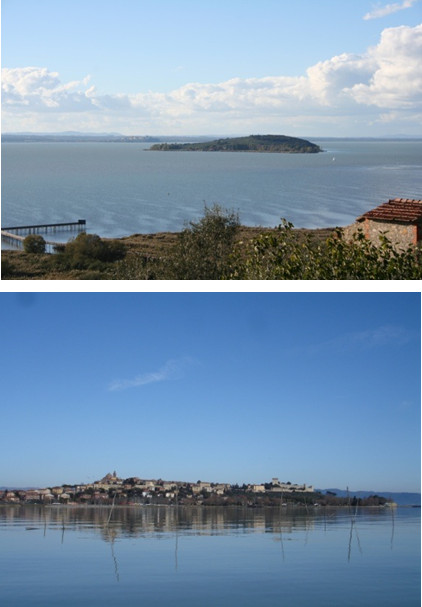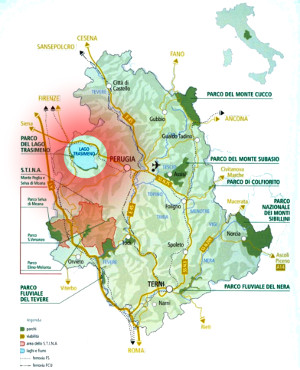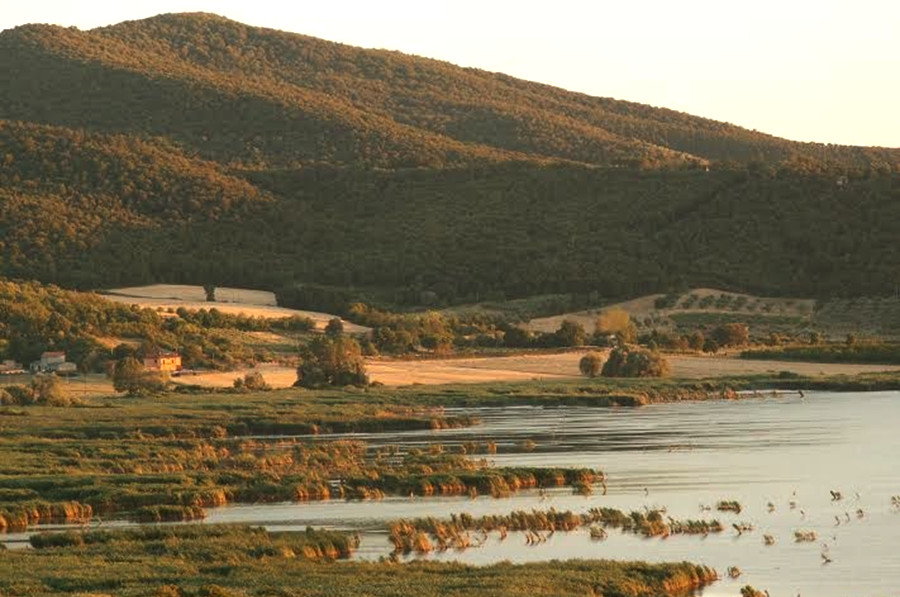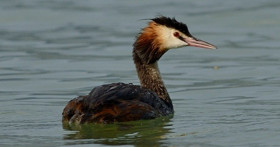Itinerary edited by UNIVERSITY OF PERUGIA 



Images of the concerned environment:

Lake Trasimeno constitutes the largest expanse of fresh water on the entire Italian peninsula. Despite the many environmental issues facing its large basin, largely due to the excessive anthropic impact, and the consequent exploitation and poor management of natural resources, Lake Trasimeno still represents, with its wide variety of environments, flora and fauna, a veritable “treasure chest” of biodiversity.
Residual riparian hygrophilous thickets, seasonal marshes, ponds, thick reeds and areas of more open, deeper water, with a seabed particularly rich in submerged vegetation, form ideal environments for a multitude of animal species typical of the wetlands. Not least among them are numerous aquatic invertebrates, fish, amphibians, and birds. While a small part of the latter are sedentary nesting species, the majority of birdlife are migratory, winter and summer visitors.
Typical species:
Great crested grebe (Podiceps cristatus)

A medium to large sized aquatic bird, belonging to the order Podicipediformes (58 cm in length, weighing 900/1100 g). The Great crested grebe is characterized by a hydrodynamic body structure, with a rather long neck, tapered head, thin beak, and brown plumage on the upper body and white underneath. During the breeding season, both males and females are adorned with showy ear tufts, and a large reddish brown collar that is hemmed in black. The young have a characteristic light plumage with black streaks. The Great crested grebe has a wide geographical distribution across Eurasia, ranging from the British Isles and southern Scandinavia to the Mediterranean region, and most of the temperate climates in Asia, from Anatolia to the Far East.
The Great crested grebe lives in humid environments, from coastal brackish lagoons to lakes, ponds, and inland marshes, primarily in lowland areas. It prefers the banks of lacustrine freshwater basins, with rich aquatic vegetation and thick reeds, where it builds floating nests with fragments of rushes and reeds. It mainly feeds on small and medium-sized fish, but also amphibians and various invertebrates. A sedentary species in much of the temperate climate of the distribution area, the populations of the northernmost regions migrate during the winter months to southern latitudes.
In Italy the Great crested grebe is present in most of the wetlands of the northern and central regions, and more rare in the south. In Umbria many pairs nest on lake Trasimeno, where they constitute one of the most characteristic elements of the local avifauna.
 Purple heron (Ardea purpurea)
Purple heron (Ardea purpurea)
This is a medium-large heron (80 cm in length, weighing 1000 g), with a characteristic slender body, long neck, narrow pointed beak, and long claws. The plumage is of a general reddish brown-chestnut colour, with soft purple-slate grey dorsal shades, a whitish neck, and thin black longitudinal stripes on the lower body. The head is characterized by a black apical tuft. The plumage of the upper body of the young is rusty-red, and an ochre-sand colour below, while the neck is without noticeable black streaks.
This species has a wide geographical distribution range across the warm-temperate climatic regions of much of Eurasia, where it lives in humid environments, from coastal lagoons to lakes, ponds and inland wetlands. It prefers freshwater lakes, characterized by lush and rich aquatic vegetation, and abundant food resources, such as small and medium-sized fish, reptiles and amphibians, insects, molluscs and other invertebrates.
A migratory species that reaches Europe in the spring, it nests in the thick reeds in the summer, and winters in the tropical regions of sub-Saharan Africa. In Italy the purple heron is widespread in most of the wetlands, above all in the Po Valley and the Maremma, while in Umbria it is present as a breeding species with a small number of couples on lake Trasimeno, where they nest in the thick reeds of the south-eastern shores, primarily in the La Valle oasis near San Savino.
 Western marsh harrier (Circus aeruginosus)
Western marsh harrier (Circus aeruginosus)
A medium to large sized falconid (52 cm in length, weighing 600 g), the Western marsh harrier has characteristic dark brown plumage with shades of grey. The male has a light brown head and neck, the female cream and yellow. The females also have a cream throat and shoulders. The young are a uniform dark chestnut brown colour.
The western marsh harrier is present in much of Eurasia, from the Iberian Peninsula to Central Asia, and from southern Scandinavia to the Mediterranean regions. It lives in humid environments, from coastal brackish lagoons to the freshwater lakes of inland areas, preferring swamps and ponds with rich aquatic vegetation, above all thick reeds. It mainly feeds on reptiles and amphibians, waterfowl and small mammals, which it hunts by circling at low altitude over marshes with reeds, wetlands, and riparian thickets.
The northern and central European populations are migratory, and winter in the Mediterranean Basin, tropical Africa, and India. In Italy this elegant predator is widespread in both coastal and inland wetlands. In Umbria they are present on Lake Trasimeno, in the swamp of Colfiorito, and artificial lakes along the River Tiber, such as the Corbara and Alviano reservoirs.
With its graceful silhouette in flight, with long wide wings, soaring and gliding over the vast expanses of reeds along the edges of lakes or swamps, this falconid is one of the most characteristic elements of the avifauna of the Umbrian wetlands.